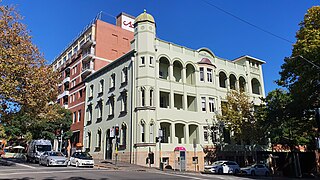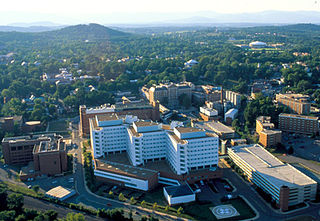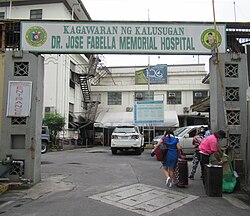
A neonatal intensive care unit (NICU), also known as an intensive care nursery (ICN), is an intensive care unit (ICU) specializing in the care of ill or premature newborn infants. The NICU is divided into several areas, including a critical care area for babies who require close monitoring and intervention, an intermediate care area for infants who are stable but still require specialized care, and a step down unit where babies who are ready to leave the hospital can receive additional care before being discharged.

Kandang Kerbau Women's and Children's Hospital is the largest public hospital specialising in healthcare for women and children in Singapore, located at 100 Bukit Timah Road.

Crown Street Women's Hospital (now-closed) was once the largest maternity hospital in Sydney, New South Wales, Australia. It was located at 351 Crown Street on the corner of Albion Streets, Surry Hills.

Tsan Yuk Hospital is maternity hospital is located on 30 Hospital Road, Sai Ying Pun on Hong Kong Island, is a public hospital in Hong Kong, It was specialising in obstetrics and gynaecology. It also operates as a teaching and training hospital for the medical and nursing students of Li Ka Shing Faculty of Medicine of the University of Hong Kong.

B.C. Women's Hospital & Health Centre, an agency of the Provincial Health Services Authority (PHSA), is a Canadian hospital located in Vancouver, British Columbia, Canada, specializing in women's health programs. It is the only facility in Western Canada dedicated to the health of women, newborns and families, and is the largest maternity hospital in the country. It is a teaching hospital and major provincial health care resource, and is a key component in women's health research.

Adventist HealthCare Shady Grove Medical Center is a 266-licensed bed acute care facility located in Rockville, Maryland. Shady Grove Medical Center provides a range of health services to the community such as high-risk obstetrical care, cardiac and vascular care, oncology services, orthopedic care, surgical services and pediatric care. Opened in 1979 as Shady Grove Adventist Hospital, Shady Grove Medical Center operates as part of Adventist HealthCare, a health-care delivery system that includes hospitals, home health agencies and other health-care services. Adventist HealthCare is headquartered in Gaithersburg, Maryland.

Neonatal nursing is a sub-specialty of nursing care for newborn infants up to 28 days after birth. The term neonatal comes from neo, "new", and natal, "pertaining to birth or origin". Neonatal nursing requires a high degree of skill, dedication and emotional strength as they care for newborn infants with a range of problems. These problems vary between prematurity, birth defects, infection, cardiac malformations and surgical issues. Neonatal nurses are a vital part of the neonatal care team and are required to know basic newborn resuscitation, be able to control the newborn's temperature and know how to initiate cardiopulmonary and pulse oximetry monitoring. Most neonatal nurses care for infants from the time of birth until they are discharged from the hospital.

Rainbow Babies & Children's Hospital is a pediatric acute care children's teaching hospital located in Cleveland, Ohio. It is affiliated with Case Western Reserve University School of Medicine and has a neonatal intensive care unit (NICU), pediatric intensive care unit (PICU), and level 1 pediatric trauma center.

The Dr. Jose N. Rodriguez Memorial Hospital (DJNRMH), formerly known as Central Luzon Sanitarium, was established in 1940, to accommodate patients with Hansen's Disease in the entire Luzon region in the Philippines. It is currently situated within the district of Tala, in Caloocan, Metro Manila, and occupies 130 hectares of land area, from the original 808 hectares. The reduction of land area was to accommodate previous homeless treated patients who eventually settled and established their own community, called Tala.
Lucile Packard Children's Hospital at Stanford (LPCH) is a nationally ranked women's and children's hospital which is part of the Stanford University Health system. The hospital is located adjacent to the campus at 725 Welch Road, Palo Alto, California. It was founded in 1991 and is staffed by over 650 physicians with 4,750 staff and volunteers. The hospital specializes in the care of infants, children, teens, young adults aged 0–21, but sometimes treats older adults and expectant mothers. Lucile Packard Children's Hospital is an ACS verified Level 1 regional pediatric trauma center, 1 of 7 in the state.

The Sloane Hospital for Women is the obstetrics and gynecology service within NewYork-Presbyterian Hospital and the Department of Obstetrics and Gynecology of the Columbia University College of Physicians and Surgeons (P&S) in New York City. It was founded in 1886 with Columbia P&S as a training and treatment center for obstetrics. It has provided over 100 years of obstetrical care. The hospital is located within Morgan Stanley Children's Hospital.

The University of Virginia (UVA) Health System is an academic health care center associated with the University of Virginia in Charlottesville. The health system includes a medical center, school of medicine, school of nursing, and health sciences library. The health system provides inpatient and outpatient care and patient education and conducts medical research and education.

Danat Al Emarat Hospital (DAE) or Mother of Pearl is a hospital dedicated to women and children in Abu Dhabi, United Arab Emirates.

St Michael's Hospital is a hospital in Bristol, England. Built in 1975, it provides maternity services for Bristol. The hospital is managed by University Hospitals Bristol and Weston NHS Foundation Trust.
Sutter Medical Center, Sacramento (SMCS) is a medical center in Sacramento, California, that has been named one of the Top 100 Hospitals in the US for five years, including 2013–2015. It is owned and operated by Sutter Health, a Northern California not-for-profit health system. The center offers both community-based and tertiary medical services. In 2015, the center consolidated its Sutter Memorial Hospital campus in East Sacramento with its midtown Sutter General Hospital location, with the opening of the Anderson Lucchetti Women's and Children's Center and the complete remodeling of Sutter General Hospital into the Ose Adams Medical Pavilion. The midtown location is where Sutter Health's first hospital, Sutter Hospital, opened in 1923. The center also includes Sutter Center for Psychiatry, providing psychiatric, mental health and chemical dependency services since 1958.

Monroe Carell Jr. Children's Hospital at Vanderbilt, also known as Children's Hospital at Vanderbilt, is a nationally ranked pediatric acute care children's teaching hospital and entity of Vanderbilt University Medical Center in Nashville, Tennessee. The hospital is affiliated with Vanderbilt University School of Medicine's Department of Pediatrics.
Kalongo Hospital, also known as Dr. Ambrosoli Memorial Hospital, is a hospital in Northern Uganda. It is a private, community hospital, serving the town of Kalongo and surrounding areas of Agago District, Pader District and parts of Kitgum District.
Trinidad and Tobago is the southernmost country of the West Indies; as of 2013, its adjusted maternal mortality rate is 84 deaths per 100 000 women; the rate is adjusted for underreporting and misclassification by the World Health Organization. The contraceptive rate, that is the percentage of women in union aged 15–49 years currently using contraception, is 42.5%. The fertility rate is 1.8 children per woman. Fourteen weeks of maternity leave with allowances is provided by the government; women typically choose to take this leave after the birth rather than before, to spend time with the newborn.

José F. Fabella was a Filipino physician and a public health advocate regarded in a biography as the "father of public health and social welfare in the Philippines."


















